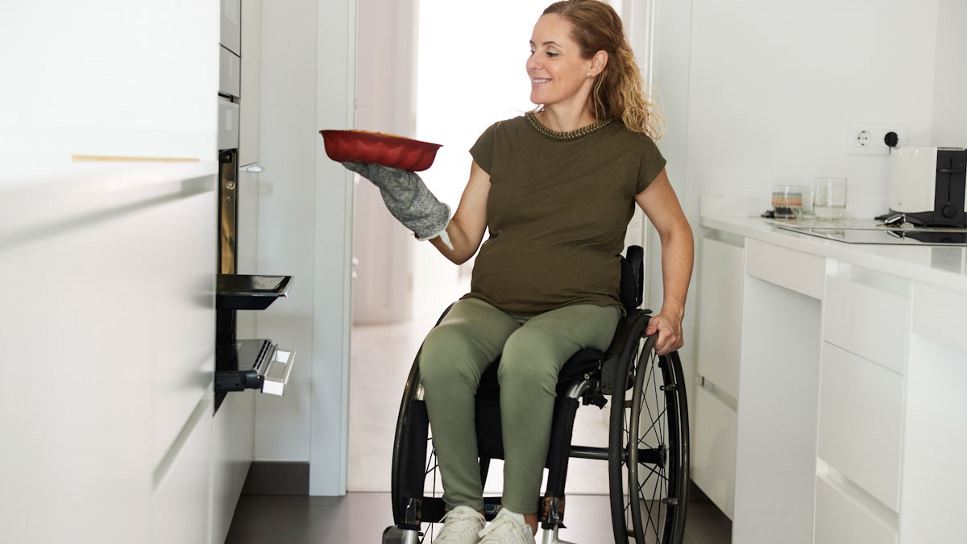Many people may take for granted the ability to prepare meals at home. More than 1 in 4 adults in the U.S. are living with a disability, and for them, this is not always a simple task. Kitchen accessibility plays a significant role in whether someone is able to prepare meals at home.
Kitchen Accessibility
Kitchen accessibility refers to the ability for people with disabilities to be able to access and use the kitchen for its intended purpose. Specific needs in the kitchen will depend on the type of disability someone has, such as mobility, cognitive, hearing or vision. The Americans with Disabilities Act has design standards for accessible kitchens which include measurements for counter height, distance between counters, as well as access to appliances, storage and sinks. However, these standards are only required in a limited number of locations, such as those owned by state and local government or for public use.
When it comes to private residences, kitchens with accessible features may already be included in the design of certain multi-family housing as required by the Fair Housing Act or per local or state building codes. Accessible modifications also may be present if the homeowner has already incorporated these features into the design of their home. For homes without accessible features, it’s left to the owner to add them.
If a kitchen renovation is not within your budget, there are several lower cost ways to improve accessibility in your kitchen. For wheelchair users, having a separate roll-under table for meal preparation and cutting is helpful if countertops are out of reach. People with difficulty reaching can also consider using appliances such as a toaster oven or microwave that can be placed at counter height. Additionally, accessible storage can be created with pull-down shelving, pull-out drawers or an easier-to-reach shelving unit.
Meal Planning
Deciding what to eat can take a fair amount of planning and a lot of different factors play a role in this process. If a disability makes it more difficult to complete daily living tasks, additional planning will be needed. Although staying on budget is important for many people, it is especially important for people with disabilities as they are more likely to live in poverty compared to individuals without a disability.
Below are several things to consider when planning your meals:
- Accessible transportation to shop for food or having groceries delivered ─ if available and within budget
- Complexity of recipes ─ easier recipes can save time and energy
- Access to kitchen equipment
- Nutritional recommendations based on a medical condition you may have, such as diabetes
- Cooking larger quantities of food and utilizing leftovers
Meal Preparation
Once you have decided what to cook, there are many adaptations that can be made to help you during food preparation. The number of accommodations you may need will vary, depending on what type of disability or disabilities you have. But many kitchen gadgets exist that can help make meal preparation easier. Some examples are:
- Cooking utensils with thicker handles for an easier grip
- Jar opening grip aids
- Electric can openers
- Vegetable choppers
- Rocker knives (adaptive knives that cut using a rocking motion)
Other ways to make meal preparation easier are by using precut fresh, canned or frozen produce and even pre-cooked items, especially for people with disabilities that affect coordination and dexterity.
Kitchen Safety
It is also important to keep kitchen safety in mind when preparing meals. Using appropriate kitchen equipment helps to prevent accidents. This can be as simple as using a non-slip mat under a cutting board or knives with a good grip to decrease the chance of them slipping in your hand.
There are many other ways to ensure safety while cooking, such as using a stable surface for food preparation and being cautious when moving hot dishes, pots or pans. For wheelchair users, having stovetops with front controls helps to prevent the need to reach over hot pots to adjust the control.
How an RDN Can Help
Working with a registered dietitian nutritionist can be an important step in meeting your goals. They can assist you with meal planning, make healthful eating recommendations and so much more, including:
- Suggest helpful shortcuts to make food preparation easier such as using pre-cut, pre-seasoned or pre-cooked foods
- Help you create a meal preparation schedule that fits into your daily life and is conducive to your specific needs
- Assist with prioritizing nutrition goals and make recommendations based on your kitchen’s accessibility, food preferences and cooking abilities
- Work within your budget and provide resources or referrals to assistance programs, if needed.
References
Find a Nutrition Expert
Looking for credible nutrition information and recommendations? The Academy of Nutrition and Dietetics' network of credentialed food and nutrition practitioners are ready to help!

